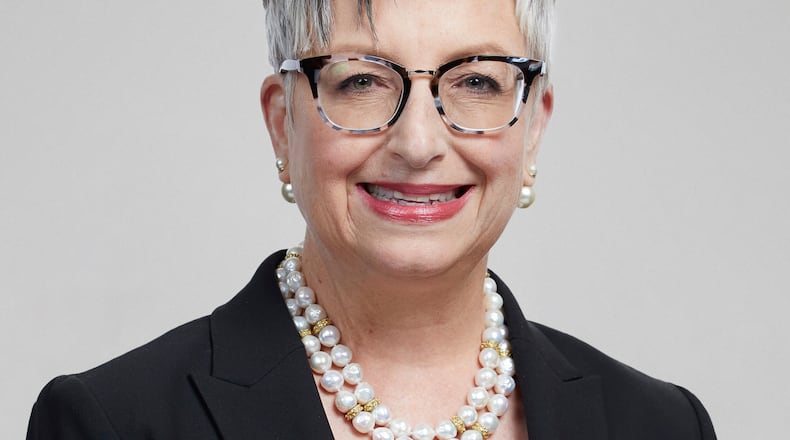The threat of a Teamsters strike this summer prompted some companies large and small to switch their business from Sandy Springs-based UPS to rivals like FedEx and the post office to make sure they could get their products to customers. Now with a five-year contract in hand, an army of UPS executives and salespeople are beating the streets to win that business back.
UPS is deploying every tool at its disposal, adding services like more weekend pickups, offering deals and even signing bonuses in some instances. UPS CEO Carol Tomé, in an interview with The Atlanta Journal-Constitution, said the company’s investment is starting to pay off.
“It takes longer than you might think it would take. ... But it’s coming back,” she said, adding that UPS aims to rebuild business by the end of 2023.
UPS, one of metro Atlanta’s biggest employers, saw its stock price and profits surge during the pandemic. This year has been more challenging amid economic turbulence, rising interest rates and labor strife. UPS’ share price is down about 11% so far this year, while the S&P 500 is up about 17% in that time.
UPS spent months working to mitigate the loss of business as contract talks with the International Brotherhood of Teamsters union heated up in the spring and into the summer. More than 500 UPS executives worked with customers to allay fears of a possible work stoppage.
“Sadly, we did have some customers divert,” Tomé said, including small businesses, medium-sized companies and large enterprise customers that were worried about how they would move their goods if a strike happened.
Shipping is a cutthroat business and UPS’ rivals wasted no time going after the top dog’s clients. While the Teamsters were threatening a strike, FedEx targeted longtime UPS customers and posted a message on its website encouraging them “to begin shipping with FedEx now.”
UPS attributed a reduction of about 1.2 million packages a day due to the Teamsters negotiations as its average daily volume dipped to 17.7 million packages in the second quarter. UPS revenue declined nearly 11% in the second quarter to $22.1 billion compared to the year-ago quarter, driven by lost customers and economic conditions. That prompted the company to reduce headcount, labor hours and operations.
FedEx benefited from UPS’ issues during the Teamsters negotiations, TD Cowen analyst Helane Becker wrote in a note to investors. But, “we also believe UPS will be aggressive in trying to win back the business,” according to Becker.
When a tentative labor agreement was reached July 25, hopes were that would be the green light for customers to begin coming back to UPS.
But then there was some uncertainty of whether the deal would get ratified in a vote by members. “Candidly some customers said, ‘I love the handshake (deal). I want to wait until you get a ratification,’” Tomé said. The deal overwhelmingly passed in late August.
‘Got to now switch ... back’
It’s not always a simple process for a major retailer to switch from FedEx to UPS. It can require altered trucking routes to carriers’ hubs, and changes to technology to connect into a different carrier’s system, for example.
“So they had to switch to go someplace else. They’ve got to now switch to come back to us,” Tomé said. UPS also has a system to quickly ramp capacity back up to bring customers back into its system without disruptions.
Another issue: “In some instances, customers who left us signed up for longer-term agreements,” she said. FedEx reportedly asked new customers to commit to using its services for longer periods of time, or otherwise pay a penalty.
“We have ways to get that business back,” Tomé said. “There’s things that we can do, signing bonuses and that sort of thing,” to pay for penalties for early termination. “That’s infrequent, but it is there.”
UPS still expects volumes in the second half of 2023 to be down year-over-year, and full-year revenue to decline from $100.3 billion in 2022 to $93 billion in 2023.
“It would have been extraordinarily naïve to walk into the year saying we wouldn’t lose any business,” Tomé said.
A former chief financial officer at Atlanta-based Home Depot, Tomé noted that she worked in retail for nearly 25 years and understands the perspective of companies that ship with UPS.
“You have customers that you have to protect so I can understand it,” she said.
The company is also working to pursue a pipeline of $7 billion in business it thinks it can win from new customers now that it has a five-year contract with the Teamsters.
“One way that we win is because of our (better) service levels” compared to competitors, which is key for retailers shipping products especially during the peak holiday season, she said.
The terms in the Teamsters deal could be an advantage in this area. It’s now no secret that full-time UPS drivers will eventually get raises up to an average top rate of $49 an hour in the new contract.
“We have a seasoned and tenured workforce, particularly in the driver ranks,” Tomé said. UPS has more than 10,000 drivers with 25 years or more of safe driving, she said. “One reason is because we pay well, so we attract the best and the brightest. And they stay with us.”
While the Teamsters have said UPS “put $30 billion in new money on the table as a direct result” of their negotiations, Tomé said the increase in labor costs due to the contract is “much, much less than $30 billion,” though she did not cite exactly how much. UPS says the contract will increase its costs at a 3.3% compound annual growth rate over the five years — but the biggest increase is in the first year.
On Wednesday, UPS shares were trading at about $157, down roughly 15% since the company reached its tentative agreement with the union.
Tomé noted that volume is down and costs are up, and also said: “I think there’s an overall concern about consumer demand.”
She expressed optimism that if UPS takes care of its customers, “Everything else takes care of itself, including the stock price.”
About the Author
Keep Reading
The Latest
Featured




